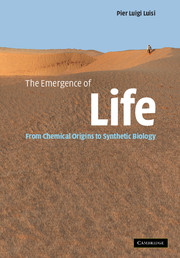Book contents
- Frontmatter
- Contents
- Preface
- Acknowledgments
- List of books on the origin of life
- 1 Conceptual framework of research on the origin of life on Earth
- 2 Approaches to the definitions of life
- 3 Selection in prebiotic chemistry: why this … and not that?
- 4 The bottle neck: macromolecular sequences
- 5 Self-organization
- 6 The notion of emergence
- 7 Self-replication and self-reproduction
- 8 Autopoiesis: the logic of cellular life
- 9 Compartments
- 10 Reactivity and transformation of vesicles
- 11 Approaches to the minimal cell
- Outlook
- References
- Index
8 - Autopoiesis: the logic of cellular life
Published online by Cambridge University Press: 17 December 2010
- Frontmatter
- Contents
- Preface
- Acknowledgments
- List of books on the origin of life
- 1 Conceptual framework of research on the origin of life on Earth
- 2 Approaches to the definitions of life
- 3 Selection in prebiotic chemistry: why this … and not that?
- 4 The bottle neck: macromolecular sequences
- 5 Self-organization
- 6 The notion of emergence
- 7 Self-replication and self-reproduction
- 8 Autopoiesis: the logic of cellular life
- 9 Compartments
- 10 Reactivity and transformation of vesicles
- 11 Approaches to the minimal cell
- Outlook
- References
- Index
Summary
Introduction
We saw in Chapter 2 how the Green Man and the farmer, in collaboration, arrived at a descriptive definition of life which distinguished living from non-living. The farmer was ignorant of biology, otherwise he would have answered from the very beginning that all living elements are made up of cells – that this is the most discriminating factor. However, the Green Man would have then asked: “What is a cell and why is a cell living?”
In fact, the life of a cell is the starting point for the development of the ideas of autopoiesis (from the Greek auto, or self, and poiesis, or producing) developed by Maturana and Varela (Varela et al., 1974; Maturana and Varela, 1980; Maturana and Varela, 1998). The aim of this chapter is to review the notion of autopoiesis and to present it in the context of present-day research in the life sciences. This will imply some addition to, and modification of, the original theory and also of a recent review of mine on which the first part of this outline is based (Luisi, 2003b).
This work is also prompted by the observation that cellular theories, such as autopoiesis, are once again attracting attention due to developments in the field of experimental cellular models. In this chapter, the notion of the chemoton developed by Tibor Ganti (Ganti, 2003) at about the same time as Maturana and Varela's autopoiesis will also briefly be considered, in order to see the analogies and differences between these two conceptually related viewpoints.
- Type
- Chapter
- Information
- The Emergence of LifeFrom Chemical Origins to Synthetic Biology, pp. 155 - 181Publisher: Cambridge University PressPrint publication year: 2006



